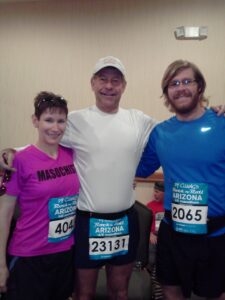My training program for the Rock ‘n’ Roll Arizona Marathon 2015 begins this week. I ran the Rock ‘n’ Roll Arizona Half Marathon every year for four years (2010, 2011, 2012, and 2013), (PR: 1:52:04), but then I had to sit out 2014 due to shin splints. Now that I’ve finished physical therapy and learned a new running posture, I’m ready to do another long race.

I will be using one of Hal Higdon’s marathon training programs for the next 18 weeks. I’ve used his half marathon training program for my previous races with a lot of success. It’s easy to lock in to his program of how far to run on what day. I’m a little worried about how fast the mileage climbs on the long run days. Â I’ll be running 10 miles by week 5. In his novice half marathon program, 10 miles is the longest run you do before the race and that’s in week 11 of a 12-week program. I hope my legs and feet can handle the stress.
I am grateful to be in the best running shape I’ve ever been in heading into a training cycle. I’ve been consistently running and stretching since March as part of the rehab from my injuries. I’m currently running 22 miles a week (2 4.5-mile runs, 2 6.5-mile runs). For previous races I was barely working out so the first 3-mile run of training was painful.
Since I’ve been running so much, I’m slightly modifying Hal’s program for the first 13 weeks. If the run in Hal’s program is less than what I would have run on my own, I’ll run the longer distance. For example, the first run in Hal’s program is 3 miles. I’d normally run 4.5 miles that day so I’ll do that distance instead.
I’ve also heard that the route for Rock ‘n’ Roll Arizona Marathon has a decent hill around Mile 20. So right when I expect to really hate myself, I have to climb a hill. (This will be awesome for a masochist like me.) My training will definitely include some hill work to prepare for this. There was a small hill in the last Rock ‘n’ Roll Arizona Half Marathon I did and I could easily tell whose training included hills and who only trained on flat ground.

Hal’s program adds 1 day of cross training to the mix. I’ll probably bike 12-20 miles on those days but there may be some hiking and other fun on those days. I think I also want to add some upper body and core strength training by doing push-ups 3 days a week – just push-ups, not the 100 Push-ups Challenge.
The real challenge in doing a race is staying dedicated to the training program. I don’t know if non-runners appreciate how much time and dedication goes into preparing for a race. The race itself is filled with excitement, fanfare, and comradery with your fellow racers. Race day is easy – if nothing else you have adrenaline to get you through it. The training is hard – long hours of pounding pavement rain or shine (most likely by yourself), scheduling your life around your runs, potentially living with perpetually sore muscles, and taking care of minor injuries. (I literally lived in KT Tape my last two training cycles.)
I’m looking forward to training for my first full marathon and being able to share the journey with you.
